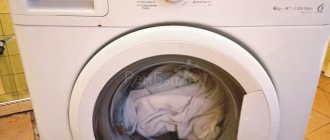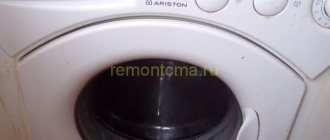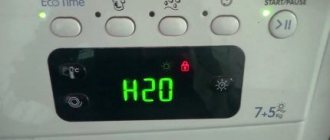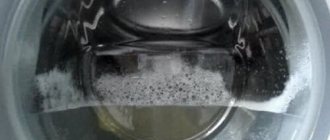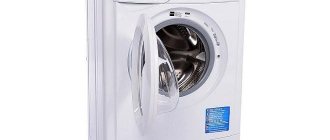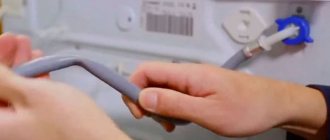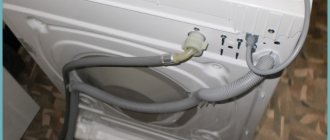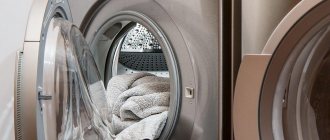A washing machine, like any other technically complex product, is not immune to breakdowns. One of the most common complaints among users is that the washing machine does not wash, that is, it refuses to perform its basic functions.. There are several reasons for this and, accordingly, ways to solve the problem of the “home assistant” failing. Therefore, before you give up and start looking for a new machine, you should first determine the essence of the problem and evaluate the possibility of eliminating it.
What to do when the washing machine does not start washing?
First of all, try to independently determine the source of the breakdown. To do this, do the following:
- Check that the door is tightly closed. The automatic machine will not turn on when the hatch is open, and no water will flow.
- Check which wash programs you have started. Perhaps they contradict each other.
- Check to see if there is water in the drum. If the washing machine does not start washing, but still makes a loud noise, there may be problems with the inlet system.
Important! Do not try to disassemble the unit and make repairs yourself - you can damage the complex automation and aggravate the problem. If the suggested options do not help, it is better to call a specialist for diagnostics. A specialist will determine the malfunction and repair the machine. Large selection of qualified craftsmen at the Tandem service.
Problem No. 4 - heating element malfunction
A malfunction of the heating element affects the cycle duration for the following reason: if a malfunction occurs, more time is spent to achieve the desired water temperature. Accordingly, the washing machine takes a long time to wash. Depending on how serious the defect has occurred in the system, one wash may take not 40 standard minutes, but up to 2 or more hours.
Solution
There is only one way out of this situation - replacing the faulty part. You can do this yourself if you have the skills to carry out such work. If you are not confident in your abilities, it is better not to take risks and call a qualified technician.
Why might this problem occur?
An automatic washing machine may not start washing for various reasons:
The drive belt has moved
One of the most common reasons why equipment refuses to turn on. This situation often occurs due to careless use or improper installation. When you turn on the machine, you hear a characteristic squeak from the drum.
You can put the belt in place yourself, but it is safer to invite a specialist to your home, since you will need to disassemble the case. In addition, the belt wears out over time and may need to be replaced with a new one.
Drain system failed
If the washing machine fails to work during the spin or rinse phase, it is most likely that there is a problem with the drainage system. The filter or inlet valve may be clogged, or the drain hose may be faulty.
Case from practice. It happens that the machine takes in water and immediately drains it. Failure to operate the machine may be due to an incorrect connection to the sewer. Check that the equipment is installed correctly and that the connection is correct.
Operation errors
There are standard rules for using automatic machines, but not everyone follows them. This may also be the reason that the washing machine does not wash and does not turn on:
- Due to the large volume of laundry, an overload occurs in the drum, and a sensor is triggered, which is responsible for the overweight of things. Remove some of the laundry and the machine will start working.
- Things are distributed incorrectly, causing them to bunch up. The machine stops and does not start washing further.
- Leakage protection is triggered. The washing process is paused due to water entering the tray. The cause of this situation may be a leak.
- Incorrect operating mode selected. If you set the program incorrectly, the machine stops after the specified time has elapsed.
Try to treat household appliances with care and follow the operating instructions.
The control board is faulty
This is a serious breakdown, indicated by the following symptoms:
- washing modes switch spontaneously;
- the time on the display does not change, the washing machine does not start;
- all the lights turn on and light up at the same time;
- the washing machine does not respond to button presses;
- The machine constantly heats or drains water.
Important! Only a specialist can replace the system board. It is strictly not recommended to try to repair the board yourself.
Another possible breakdown is when the washing machine turns on, but does not start the wash, while water constantly collects and remains at the same level. In this case, you need to inspect the drain hose connection. The problem can be solved by connecting the equipment correctly - water may leak out due to an incorrect connection. Another possible cause of this malfunction is failure of the intake valve, in which case it will need to be replaced.
Problem #2 - clogged pump filter or drain hose
Such a malfunction will result in a smaller passage inside the drain hose for water supply and drainage. This is why the washing machine takes a long time to wash.
Important! This problem most often appears when the system is not used correctly. For example, if you do not check the contents of your pockets or do not use special laundry bags. Then coins, hair, debris, small buttons, hooks and other objects get into the drain hose or filter and clog the flow.
Solution
Unscrew the hose and get to the filter, clean it and continue to carefully sort and prepare things for wet cleaning, then the problem will no longer arise.
Important! The pipes inside the unit may also become clogged. Solving this problem also requires cleaning them.
Failures that prevent the washing machine from washing
The washing machine also does not turn on if individual parts of the unit fail:
- Closing sensor on top-loading models. The limit switch does not allow the machine to start washing when the door is open. If it fails, the motherboard does not receive the enable signal and the machine does not turn on.
- Door locking device on front-loading models. If the door is not tightly closed, the lock prevents the machine from turning on. If it breaks, a replacement is necessary.
- Selector. When switching the programmer, the selector handle is pulled out and locked in the new position. When this does not happen, a new cycle does not start.
- Engine. Washing, spinning and rinsing clothes occurs when the drum rotates, which drives the motor. If the door lock is activated, the machine hums, but the drum does not rotate, this indicates a problem with the engine.
- Electronics. The entire operation system of the machine is controlled by the control board. If a short circuit occurs, the system loses communication with individual units of the unit and does not start the cycle.
Before calling the specialist
First, try to carry out simple diagnostics yourself to make sure that the problem is a malfunction of the machine itself:
- First of all, you should make sure that the machine is connected to the network. If everything is in order, but it still does not turn on, make sure that there is current in the network. Voltage fluctuations can lead to a malfunction of the outlet, and the one in which the machine is plugged in. To make sure there is voltage, try connecting another electrical appliance to the same outlet.
- Check that the plug and the cord itself are in good condition and free of damage. If everything is fine with the power supply, but the washing machine still does not turn on, then you should look for a fault in the device itself. Carefully inspect the surface of the plug and cord. Make sure there is no burning on them and no unpleasant smell of burning plastic. If such damage is discovered, you should not reconnect the machine to the network. The malfunction in this case will consist of damage to the wire, and to solve the problem it is enough to replace it.
If everything is in order with the cord, plug and socket, then the fault is probably in the internal technical components of the device and this cannot be done without the help of a professional.
Error codes
| Ariston | Bosch | Indesit | LG | Samsung | Zanussi | |
| The hatch is not closed, the lock is faulty | F17, DOOR | F01 | F17 | dE | DE, DOOR | E41 |
| Motor problems, short circuit | F01 | E02 | F01 | — | — | E51 |
| Water does not flow into the drum, the water level sensor is not working correctly | F04 | F02 | F04 | I.E. | E1 | E11 |
| Drum balancing is out of order, laundry is overloaded | — | — | — | UE | E4 | E39 |
| Water leak | — | F04 | — | E1 | E9 | E13 |
| Button error | F06 | — | F06 | — | — | — |
How does the machine draw water?
If you have problems starting the wash, the first thing to do is try again, assessing the quality of the wash. Immediately after activating the main program, pull out the detergent tray and look at the behavior of the machine. If the equipment hummed and water poured into the powder receptacle, but after a few minutes the system froze, then the problem is in the heating element.
It’s another matter when the set did not start and the washer stopped working. In this case, the reason for the freezing lies in a banal blockage - one of the pipes connected to the powder receiver or the filling filter mesh is clogged. Fixing the problem is simple: just remove the top cover, loosen the clamps and remove any stuck debris or scale. If there are problems with the heater, the instructions on what to do will be different. Below is a step-by-step algorithm.
Possible actions and repairs
High-tech and structurally complex equipment requires detailed diagnostics, some knowledge and special tools. Therefore, an adequate assessment of your capabilities is the first mandatory point before any manipulation with such equipment.
The locking device needs to be replaced
The reason for its failure may be a long service life. The reason is the deformation of the bimetallic plate due to a constant temperature difference. Replacing an element requires disassembling the locking device (UBL).
- Unscrew the two screws securing the lock to the body. The element is removed by supporting it with your hand from the back.
- The wires with connectors are disconnected from the faulty part, then they are connected to a new spare part. It is again fixed in its rightful place with screws, the cuff is returned to its previous position, and secured with a clamp.
- They check the performance of the machine and do a test wash.
It happens that on the way to troubleshooting a closed door gets stuck and jammed. In this case, they disassemble the upper part of the housing, find the lock by touch, and press its latch to open the hatch. Then proceed in the same way.
Testing and repair of the command device
If the results of checking the remaining nodes are zero, then there is only one potential culprit left - the programmer (command device). In this case, quite painstaking and careful work remains. The unit is disassembled into small parts, then the “patient” is examined.
- to gain access to the command device, first disassemble and remove the front panel of the washing machine;
- remove the electronic module and begin disassembling it;
- remove the cover by pressing the latches located on the sides;
- remove the board, inspect it for burning, if there are such places, solder them;
- The resistance at the contacts is tested with a multimeter;
- check (clean) the central gear, then all elements, including the core, are removed;
- test the electric motor winding, replace the wire if burns are detected;
- the parts are treated with alcohol and placed back, observing the reverse assembly order.
Not all washing machine models have relatively simple programmers; some are quite complex. In this case, no one can guarantee a successful repair, so it is more logical to replace the unit with a new module.
New cars - problems with the button
The latest generations of washing units are capable of presenting another “surprise”. This is a problem with the “Start” button, since the current supply to it comes directly from the power cord. To check the potential source of problems, do the following:
- disconnect equipment from the network;
- remove the upper part of the body;
- dismantle the control panel;
- disconnect the wires from the button;
- connect the multimeter, plug the device into the network;
- test the presence of current when in the on position.
If the button functions normally, then the search for the culprit devices continues. Otherwise, the faulty part is replaced. Some washing machines have a different operating principle, where the voltage is supplied to the electronic module/programmer. It all depends on the manufacturer and the specific model.
Breakdown prevention measures
The proper operation of any household appliance depends on many factors: the quality of parts, compliance with assembly technology, transportation and operating conditions. Of course, there is a manufacturing defect, but if a breakdown is diagnosed due to the fault of the manufacturer, the equipment can be repaired or replaced under warranty. In most cases, breakdowns occur due to the fault of the user. Operating equipment at the limit of its functionality will sooner or later lead to breakdowns.
Before you start using the washing machine, you must carefully study the operating instructions. Taking good care of your equipment is an almost 100% guarantee of its flawless and long-term operation.
So, to avoid breakdowns you must:
- connect the machine through a residual current device to mitigate power surges in the network;
- to prevent the appearance of mold and unpleasant odors, external parts and surfaces should be wiped with a cloth after washing;
- do not run several washing cycles in a row - equipment should rest, breaks between washes should be at least two hours;
- twice a year you need to descale the machine, run the machine without laundry at high temperature with the addition of anti-scale agents;
- use high-quality detergents suitable for automatic machines;
- excessive load of laundry is a common cause of short circuit due to overheating of the motor;
- At least once every two years, invite a washing machine repairman for a routine inspection.
Door problems
Problems with the door in the washing machine
The door may not work in the washing machine if:
- There is a mechanical failure. As a rule, then a characteristic click is not heard;
- Problems in the electronic system. That is, you close the door, hear a click, but the lock does not work.
Causes of mechanical failure:
- Skewed hinges. In this case, the tongue on the door does not fit into the mating groove. You need to check the level, as well as the fastening. If there is a distortion, adjust what you can do without a specialist;
- Tongue distortion. When the tongue does not fit into the lock. Perhaps the rod that holds it in the desired position has fallen out. And then they disassemble the door and put the rod in place or change the hatch handle in the service;
- Guide broken. In some models, the door closes thanks to a plastic guide. Since the plastic can break, the hatch may close without a clicking sound and without locking in the “Closed” position. The solution to the problem is to change the guide in the service.
Causes of electrical failure:
- The locking device is faulty. If the plates of this device are deformed under the influence of current, the interlock no longer functions and must be replaced;
- Foreign body. A foreign object (coins, debris) may get into the locking device and the door will not close. The solution is to remove the foreign body;
- Control module failure. The device does not receive a command from the “brain” to close the door. This happens if the contacts burn out or there is a software failure. The module needs inspection and replacement or repair.
If the heating element is working properly
If testing of the heating element does not reveal any blockage, breakage or breakdown, then the washing does not work due to the temperature sensor. The temperature sensor is located on the heater body near the central nut. It should be removed and ringed. The instructions are as follows:
- disconnect the connected wiring from the sensor;
- unhook from the heating element;
- turn the multimeter into ohmmeter mode;
- attach the probes to the thermistor contacts;
- estimate the resistance (when operating at a temperature of about 2500C, the device will show 2000 Ohms).
The test continues by immersing the sensor in boiling water and then measuring the resistance. When the temperature rises to 5000C, the readings should drop to 1300 Ohms. If the values are different, then the thermistor is faulty. The situation cannot be corrected by repair, only replacing the temperature sensor.
Is the thermistor OK? Then we inspect the wiring connected to the heater for damage and loose contacts. If no problems are identified during the diagnostics, then you should contact the service. The control board may have fallen off. Here, independent intervention is fraught with aggravation of the breakdown, even leading to the “fatal outcome” of the equipment.
Interesting:
- Timer freezes on washing machine
- Electrolux washing machine frozen
- Water flows from below under the Atlant washing machine
- The washing machine is stuck on the spin cycle and won't stop.
- Zanussi washing machine does not rinse
- Water is leaking from below the Samsung washing machine
Reader comments
- Share your opinion - leave a comment
What is needed to find and solve problems?
To diagnose and eliminate the cause of equipment failure, the technician needs:
- new spare parts;
- screwdrivers;
- insulating tape;
- brush, napkin, sharp knife - for cleaning damaged or dirty parts;
- Passport products;
- The main tool is a multimeter.
A camera (or a phone with it) will be an indispensable assistant; using this technique you can record the dismantling order. The operation will give a chance to avoid the slightest error during assembly.
